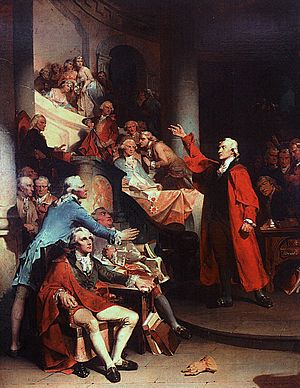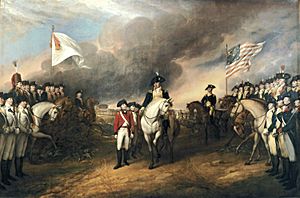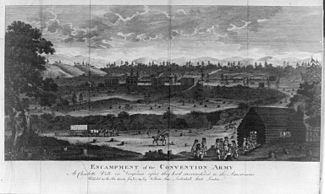Virginia in the American Revolution facts for kids

Virginia played a big part in the American Revolution. This war was when the American colonies fought for their freedom from Great Britain. Virginia was one of the first colonies to speak out against the British government. The war ended in 1781 when General Cornwallis and his British army were defeated at the Siege of Yorktown. Many important Virginians helped lead the Revolution, like George Washington, Patrick Henry, and Thomas Jefferson.
Contents
Why Virginia Fought for Freedom

People in Virginia started to feel unhappy with the British government after the French and Indian War ended in 1763. The British government had spent a lot of money on wars. To pay for this, they started to tax the American colonies more.
In 1763, there was a disagreement called the Parson's Cause. The Virginia government had passed a law about church salaries. But King George III said no to this law. A lawyer named Patrick Henry became famous for arguing against the King's decision. He said it was unfair.
New Taxes and Protests
The British Parliament passed the Sugar Act in 1764 and the Stamp Act in 1765. These acts added taxes on goods like sugar and paper. The General Assembly (Virginia's government) did not like these taxes. They believed that only their own elected leaders should be able to tax them, not the British Parliament. This idea was called "no taxation without representation."
Patrick Henry gave a strong speech against the Stamp Act. He warned King George III to learn from history, mentioning leaders who had been overthrown. The Virginia legislature then passed the "Virginia Resolves," which were statements against the tax. The governor, Francis Fauquier, responded by closing the Assembly.
Even after the Assembly was closed, people in Virginia kept protesting. In 1766, a court in Northampton County said the Stamp Act was not valid. Groups like the Sons of Liberty also protested. A Virginian named Richard Bland wrote a paper saying that Virginia was part of the British Empire, but it only answered to the King, not to the British Parliament. This idea became a key part of the Revolution.
The Stamp Act was eventually removed. But Britain added other taxes and tried to send people accused of rioting in Boston to London for trial. This made Virginians even angrier. The Assembly met to protest this, but Governor Botetourt closed it again. The Virginia leaders then met at Raleigh Tavern. They agreed to stop buying British goods. Britain later removed most taxes, except for the tax on tea.
Working Together for Change
In 1773, leaders like Richard Henry Lee, Thomas Jefferson, Patrick Henry, and George Mason created a special group called a committee of correspondence. This group was officially part of Virginia's government. Its job was to share news and ideas with other colonies about problems with Britain.
In 1774, after Britain closed the port in Boston, Virginia's leaders showed support for Massachusetts. They declared June 1, 1774, a day of "Fasting, Humiliation, and Prayer." Governor Lord Dunmore again closed the legislature. So, the first Virginia Convention was held at Raleigh Tavern. They decided to boycott British goods and elected delegates to the Continental Congress. A Virginian, Peyton Randolph, became the president of this Congress.
The War Begins in Virginia
On April 20, 1775, the day after the Battle of Lexington and Concord in Massachusetts, Governor Dunmore ordered British soldiers to take gunpowder from the magazine in Williamsburg. Patrick Henry led a group of Virginia militia (citizen soldiers) to stop Dunmore. They reached an agreement where the British paid for the gunpowder.
This event made Dunmore very unpopular. He soon left the Governor's Palace and went to a British ship near Yorktown. On November 7, Dunmore announced that Virginia was in rebellion. He also said that any enslaved person who fought for the British would be freed. By this time, George Washington was leading the American forces. Virginia was being led by a Committee of Safety.
First Battles in Virginia
On December 9, 1775, Virginia militia fought Dunmore's forces at the Battle of Great Bridge. The British had a fort guarding the way to Norfolk. The British attacked, but the militia won the short battle. After this, Dunmore's ships attacked and burned Norfolk on January 1, 1776.
For a while after this, there wasn't much fighting in Virginia itself. However, Virginia sent soldiers to help in battles in other colonies. For example, Daniel Morgan and his skilled marksmen fought in northern battles. Charlottesville also became a prison camp for British and German soldiers captured at the Battle of Saratoga.
Virginia also sent forces to its western frontier, which included parts of what is now Ohio. George Rogers Clark led these forces. He captured a fort at Kaskaskia and won the Battle of Vincennes. He even captured the British governor, Henry Hamilton. Clark kept control of areas south of the Ohio River for most of the war.
Virginia Declares Independence
The Fifth Virginia Convention met on May 6, 1776. On May 15, 1776, they declared Virginia a free and independent state. They also told their delegates at the Continental Congress to propose independence for all the colonies. Richard Henry Lee introduced this idea on June 7.
While the Congress debated, the Virginia Convention adopted George Mason's Bill of Rights on June 12. Then, on June 29, they adopted a new constitution. This constitution made Virginia an independent state, or "commonwealth." The Continental Congress approved Lee's proposal on July 2. Two days later, on July 4, they approved Thomas Jefferson's Declaration of Independence.
Virginia's new constitution created a government that lasted for 54 years. It had a governor and a two-part legislature (the House of Delegates and the Senate). The legislature chose a governor each year, and Patrick Henry was the first. They also chose a council of eight people to help the governor. Later, Thomas Jefferson, Edmund Pendleton, and George Wythe were chosen to update Virginia's laws to fit the new constitution.
War Returns to Virginia
In May 1779, the British brought the war back to Virginia's coast. Admiral George Collier landed troops at Hampton Roads. They used Portsmouth as a base after destroying the naval yard. This was part of a plan to stop trade with the West Indies. But the British stopped this plan when more troops from General Henry Clinton did not arrive.
Attacks on Richmond
Fearing that Williamsburg was not safe, Governor Thomas Jefferson moved Virginia's capital inland to Richmond in 1780. In October, the British tried to invade Virginia again. British General Alexander Leslie came to the Chesapeake Bay with 2,500 soldiers. He used Portsmouth as a base. However, after the British lost the Battle of Kings Mountain, Leslie moved south to join General Charles Cornwallis.
In December, Benedict Arnold attacked Richmond. Arnold had once been an American general but had switched sides to the British. He led British soldiers and German mercenaries. Jefferson had to leave the city. Arnold's forces burned much of Richmond before leaving. They also burned and looted along the James River.
The Yorktown Campaign
Arnold moved his base to Portsmouth. Later, General William Phillips joined him with 2,000 more troops. Phillips led attacks that destroyed military and economic targets. Virginia's defenses, led by General Friedrich Wilhelm, Baron von Steuben, tried to fight back at the April 1781 Battle of Blandford, but they had to retreat.
George Washington sent the French General Lafayette to help defend Virginia. Lafayette marched south to Petersburg, stopping Phillips from taking the town right away. Cornwallis, who was having trouble in the Carolinas, moved his army north to join Phillips and Arnold. He then started to chase Lafayette's smaller army. Lafayette had only 3,200 soldiers, while Cornwallis had 7,200. Lafayette avoided direct battles and mostly bothered Cornwallis with small fights.
Lafayette retreated to Fredericksburg. He met up with General Anthony Wayne and then marched southwest. Cornwallis sent two smaller groups of soldiers. One group, led by Colonel John Graves Simcoe, went to take the arsenal at Point of Fork. The other, led by Colonel Banastre Tarleton, marched to Charlottesville to try and capture Governor Jefferson and the Virginia legislature. The mission to Point of Fork forced Steuben to retreat further. Tarleton's mission only captured a few legislators and officers. A man named Jack Jouett had ridden all night to warn Jefferson and the legislators that Tarleton was coming.
Cornwallis brought his army back together at Elk Hill. Then he marched to the Tidewater region of Virginia. Lafayette, now with von Steuben, had 5,000 troops and followed Cornwallis.
General Clinton ordered Cornwallis to move his troops down the Virginia Peninsula towards the Chesapeake Bay. Clinton planned to take some of Cornwallis's army to attack New York City. Cornwallis marched through Williamsburg and near Jamestown. When Cornwallis seemed to be crossing the James River, Lafayette saw a chance to attack. He sent 800 troops under General Wayne to attack what they thought was Cornwallis's rear guard.
But Cornwallis had set a trap. Wayne's smaller force was almost caught by Cornwallis's main army of 5,000 soldiers at the Battle of Green Spring on July 6, 1781. Wayne ordered a charge against Cornwallis to make it seem like his force was bigger and to stop the British advance. This trick worked, and the Americans were able to escape. The Americans lost 140 soldiers, and the British lost 75.

Cornwallis moved his troops across the James River to Portsmouth to wait for Clinton's orders. Clinton decided that a position on the peninsula should be held. He thought Yorktown would be a good naval base. Cornwallis was ordered to move his troops to Yorktown and start building forts and a naval yard.
The Americans had first thought Cornwallis would move to New York or the Carolinas. But when they found out about the forts at Yorktown, they started to surround the city.
General Washington saw a chance for a big victory. He moved some of his troops, along with French troops led by Rochambeau, from New York to Virginia. The plan depended on more French troops and a large French navy led by Admiral de Grasse. On September 5, Admiral de Grasse defeated a British navy fleet at the Battle of the Virginia Capes. This victory meant the French controlled the waters around Yorktown. Cornwallis could not get more troops or supplies, and he could not escape by sea.
Between October 6 and 17, the American and French forces surrounded and attacked Yorktown. Cornwallis was outnumbered and completely surrounded. He decided to surrender. The surrender papers were officially signed on October 19. Because of this defeat, the British King lost control of Parliament. The new British government offered peace in April 1782. The Treaty of Paris of 1783 officially ended the war.
Virginia's Role After the War
Many Virginians who were involved in the American Revolution went on to serve in the early government of the Commonwealth of Virginia and the United States.



